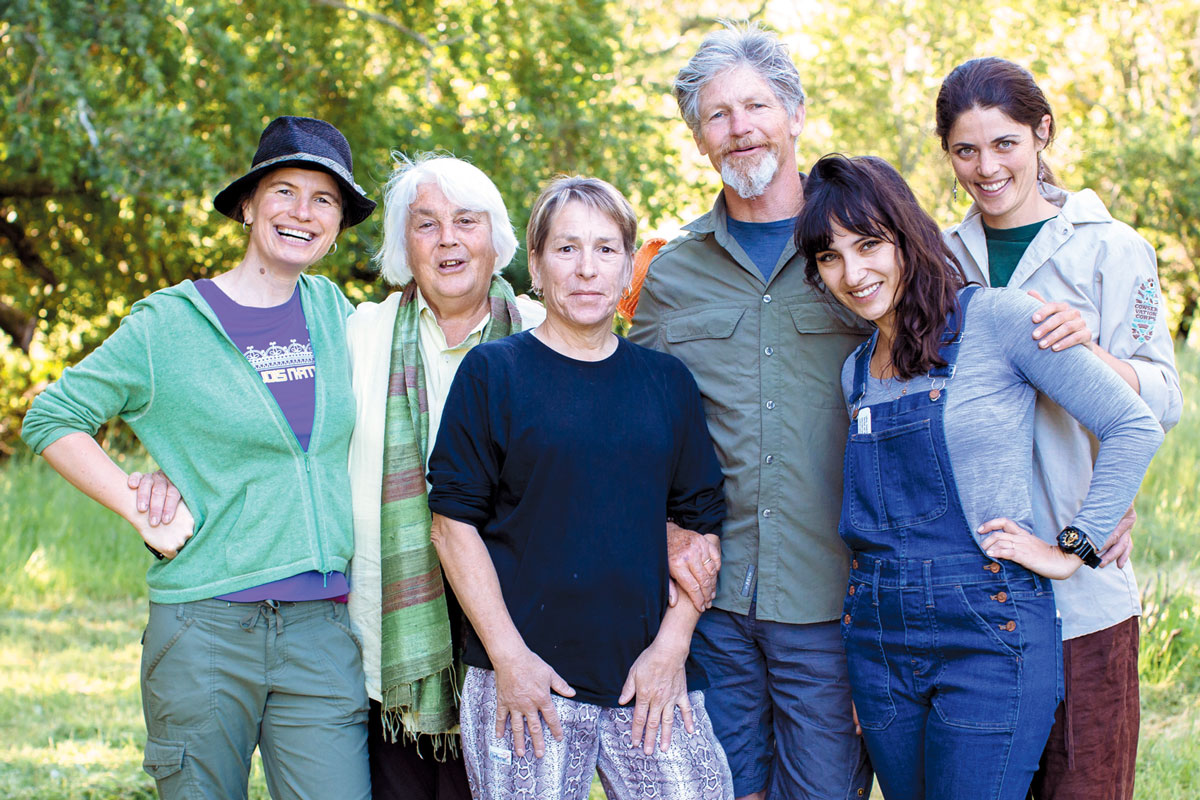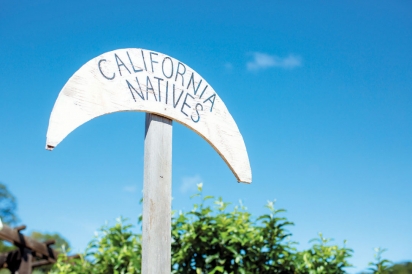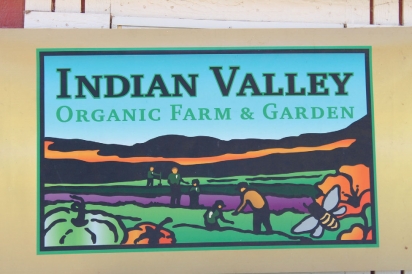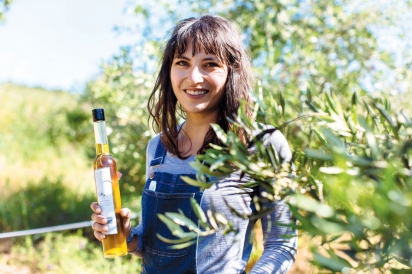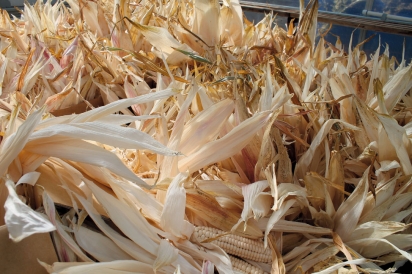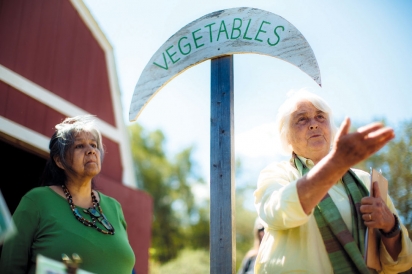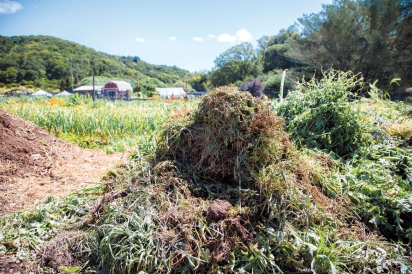Indian Valley Organic Farm and Garden
Cultivating Future Farmers
A healthy ecology is characterized by layers of uncountable contributors and beneficial partnerships, and that is exactly what has made the Indian Valley Organic Farm and Garden (the “IV Farm”) a success.
Launched in the spring of 2009, the 5.8-acre farm grew, as if by magic, from a stretch of barren land on a hillside above the College of Marin’s Indian Valley campus in Novato. The result of the collaborative efforts of the College of Marin and the California Conservation Corps North Bay, along with UC Cooperative Extension, Marin Master Gardeners, Marin Community Foundation and the Marin County Board of Supervisors, the IV Farm is part of an initiative developed from a countywide commitment to promoting a greater understanding and appreciation of the valuable role of agriculture in Marin County, and to promote local food systems by teaching sustainable agricultural practices. It is the only teaching farm in the county.
Modeled after successful educational farms in Fresno, Santa Cruz, San Diego and elsewhere, the IV Farm has blossomed into a full-fledged agricultural enterprise and teaching facility providing work-study opportunities for College of Marin students, as well as environmental career paths for disadvantaged youth and adults. The organic plants and produce grown on the farm are offered for sale to the public and local restaurants, as well as being served in the Novato Unified School District cafeterias.
It is also a slice of paradise.
Part rigorous laboratory, part botanical shrine, the IV Farm has become a horticultural haven, a showcase abundant with colors, sounds and smells: enticing fruits ripening before your very eyes, bees buzzing about and the smell of lemon balm and lavender lifted by the breeze. Pea pods dangle from long trellised rows of wandering vines while heirloom corn and tomato sprouts work their way out of the ground toward fruition. Cover crops thrive in otherwise fallow corners, attracting beneficial insects and refueling and fortifying soils.
The landscape is dotted with huge earthen towers being molded and manicured by students donning floppy hats and muck boots and wielding rakes and shovels. The care and thoughtfulness of these apprentice farmers as they shovel and sculpt belies the makeup of the mounds; indeed, they are comprised largely of manure, a powerful and pungent source of nitrogen. These masterpiece compost piles are also rife with cuttings of grasses and other green organic matter and in honor of balance—a gardener’s great virtue—woody stalks and trimmings bring carbon to the mix.
Periodically, huge thermometers are poked into the center of each tower, then read as carefully as if checking a baby’s temperature. Too much heat will kill off helpful bacteria, while just enough heat encourages the ongoing miracle of decomposition.
“Keep going ... those are still not edgy enough!” instructs Wendy Johnson, founding farmer, teacher and resident sage of all things cultivated and wild at the IV Farm. Johnson, whose sleek silver hair is the only real clue to her age, uses a pitchfork to poke at her students’ sculptures. She wants the compost piles to be shaped into perfect five-by five-foot squares, broad-based and sharp shouldered. No straggling straw or clumps of dung allowed.
Longtime master gardener at the Green Gulch Zen Center, mentor for Alice Water’s Edible Schoolyard, and author of Gardening at The Dragon’s Gate (Bantam, 2008), a guide to gardening and life, Johnson is a refined blend herself, a balance of detailed, particular and methodical and ecstatically inspired and humble in the face of natural mysteries.
Every semester Johnson teaches a class at the IV Farm called Principles and Practices of Organic Farming in partnership with another local farming superstar, Steve Quirt. Some early students referred to Johnson and Quirt as the Picasso and Matisse of organic gardening. “Step into the richness,” Johnson entices newbie farmers as they begin what she understands will likely be a long and meaningful dance with the land. Enroll in the class and prepare to have dirty fingernails all semester, if not for the rest of your life.
If you can get in: The quality of the IV Farm curriculum is widely known throughout the region, so securing a spot in Johnson and Quirt’s course can be a bit like trying to get tickets to a Star Wars film on opening night. In fact, the entire College of Marin’s Environmental Landscape department, which offers classes in soil science, integrated pest management, landscape design (including web components), plant identification, irrigation and landscape ecology, has burgeoned. Enrollment in these other classes tripled during the first year that the IV Farm courses were offered.
On my visit to the IV Farm, Johnson deflects questions about herself to focus the attention on the young Conservation Corps farmers who run the farm and shepherd programs for the community. They also manage the farm stands and plant sales at the farm and local farmers’ markets. She goes on and on about the caliber of the individuals who work the land day by day, and introduces me to current and former farm coordinators Rebecca Hoehn and Amy Ridout, as well as farm specialist Kaylin Lustig, propagation specialist Vic Stavig, and high school interns Merone Eckert and Ana Paula Kitos Vasconcelos with the same pride and passion she exhibits for thriving plots in the garden.
These hands on team members do everything from driving tractors to propagating plants to teaching, and they, along with the never-ending behind-the-scenes development and fundraising work of the Conservation Corps and College of Marin leaders, are key players who made this dream farm a reality.
The classes, it must be said, are for the courageous and committed, those who recognize there is no way forward but the pesticide-free path and are willing to back up this belief with hard work, both in the classroom and on the farm. Sign up and you will not just be reading, writing, sowing and harvesting. You will, among other things, be double-digging and propagating, winnowing and seed-saving. You will know well the structural makeup of silt and clay and soil, and you will work tirelessly to keep the soil in your beds robust with organic matter. You will observe and, to the best of your ability, make peace with weeds. In turn, those weeds will instruct you about the makeup of your land. You will always make your planting rows the proper width, and you will use your hand, fingers spread wide, to establish a diamond-shaped pattern that gives young vegetable starts just the right amount of room when you place them in your perfectly sized rows. When you water these young plants in, you will spray the water from the hose in a lovely rainbow arc to best emulate a first spring rain. You must not drench the infant plants and “clog their little stomato mouths on their leaves,” as Johnson will remind you.
Mostly, you will become a disciple, a practitioner of best organic practices, and you will carry your wisdom forward, using it wherever you go—from backyards to school gardens to fully integrated farms—and sharing your experience and knowledge with your farming brethren.
“We want to be an example of public education at its best,” says Johnson. “This is the vision. We see this farm as a pathway.” She speaks with pride of programs and partnerships with community organizations such as the Youth Corps and Community Grows that bring students onto the IV Farm for environmental job training.
Johnson’s excitement is palpable as she shows off a basket full of pearly cobs of Seneca White Corn. “Just look how perfect this is!” says Johnson as she carefully cradles the ears, each bursting with white kernels, all harvested from the first nine rows cultivated on the farm. “I get emotional looking at it, it is so perfect.”
This first harvest of the ancient and precious native corn is a result of a relationship between the IV Farm and the nonprofit Cultural Conservancy of San Francisco, led by Melissa Nelson and a large Native American inter-tribal contingency with representatives of tribes coming from as far away as upstate New York. The Cultural Conservancy, whose mission is to protect and preserve indigenous cultures, stewards one and a half acres on the IV Farm, including an Ethnobotany Teaching Garden that grows culturally significant Native American plants such as Soap Root, Oregon Grape and Elderberry. The Native Foodways Garden on the farm features indigenous heirloom plants including the Seneca Corn, Tepary Beans, Taos Blue Hubbard Squash and Hopi Blue Dye Sunflowers.
“We want to preserve these crops of antiquity,” says Johnson. “They are also the crops of hot, dry climates, and they are so important in times of drought.” Tribal leaders offer regular workshops on native agricultural practices and craft s in the garden and each fall the groups host a Three Sisters Harvest gathering, a day of ceremony, seed-saving, and a native food feast, to which the public is invited.
As IV Farm devotees will attest, hours and days pass at a different pace here, and time is kept by observing the seasons as they come and go, by the slant of the sun in the fall and the direction of the wind in the spring. Students also come to understand the passing of time in the greater geologic sense: What is the history of this land? What is the nature of the soil? What has grown here over the ages, and whom did it feed? Seen through this lens, the eight years since the first shovel broke ground at the IV Farm is understood as barely the blink of an eye.
But, as those who work on the farm can tell you, watching and waiting, year after year, for a young tree to mature and bear fruit, can make those 365 days feel like a very long time. The northern slope of the IV Farm is home to an olive grove and fruit orchard, and two local tree gurus, John Valenzuela and John Heenan, oversee the trees and hold workshops for students on orchard planning, propagation, grafting and pruning.
Unfortunately 2014, the year of the first IV Farm olive harvest, was the year when olive crops across the region were devastated by the olive fruit fly. The unharmed yield at the IV Farm was almost nil, and the wait for olive oil would continue another year.
Finally, last October, with great anticipation, students and staff at the IV Farm harvested an abundant and healthy crop, 800 pounds of olives from 58 trees, a Tuscan blend of Leccino, Maurino, Moraiolo, Frantoio, Pendolino and Coratina olives. Slender bottles of glistening Indian Valley Farm & Garden olive oil are the manifestation of days and weeks and years of expertise and labor, the sustained effort of hundreds of individuals. They seem a fitting offering from and emblem for this special place that has involved so many and captured the heart of our North Bay community.


